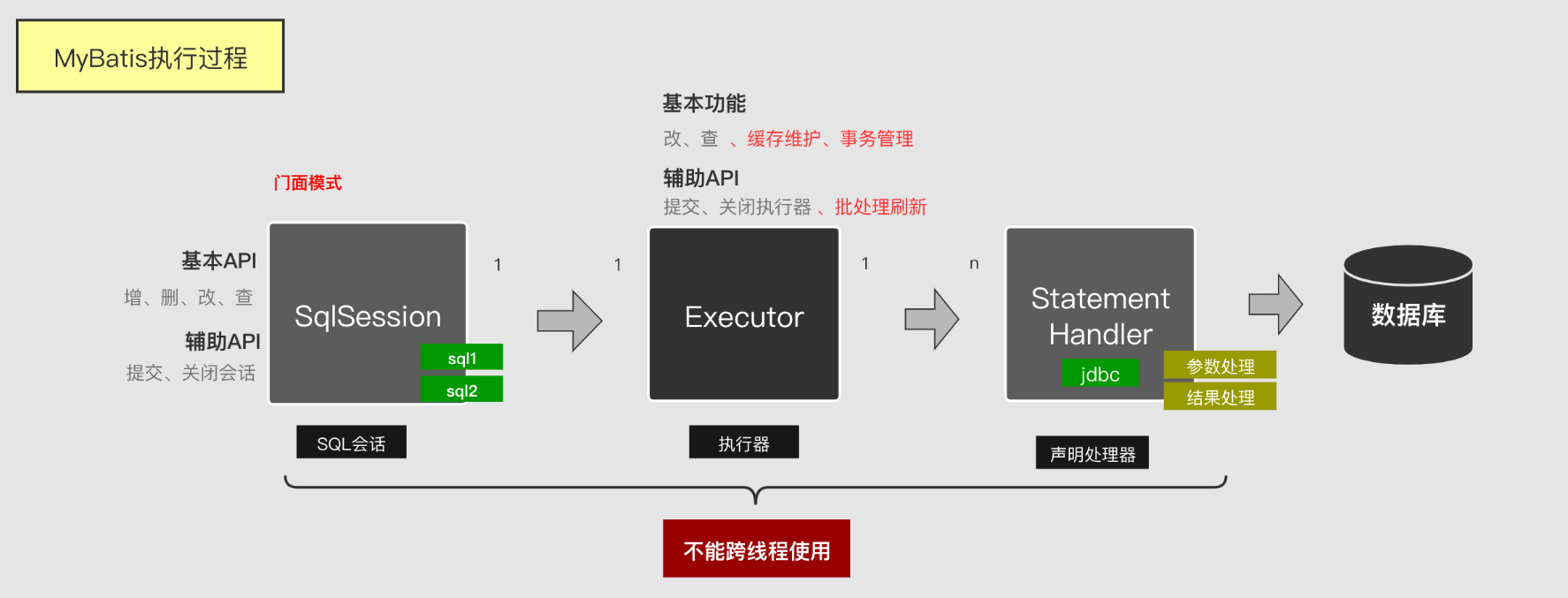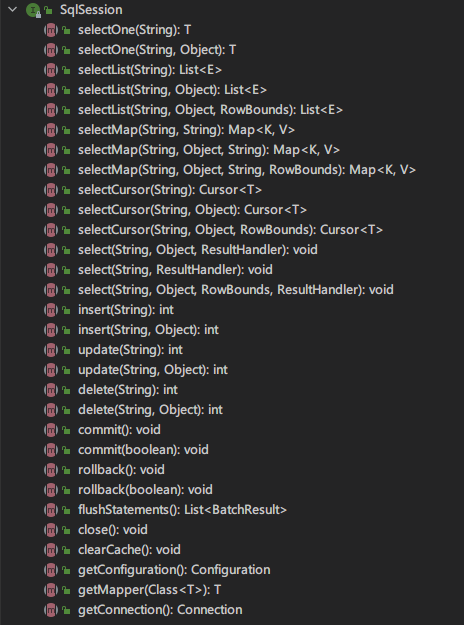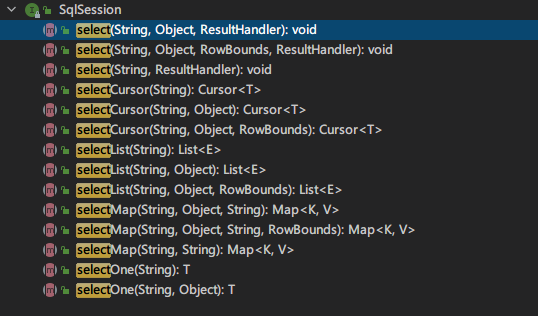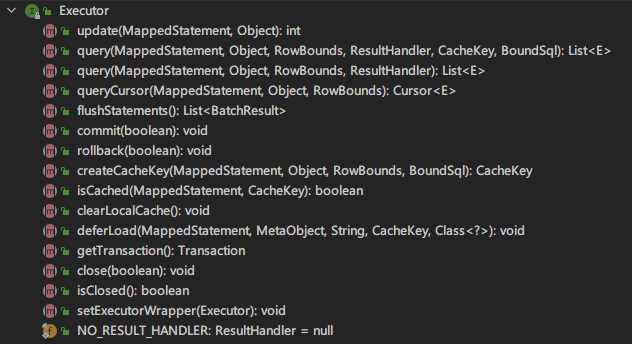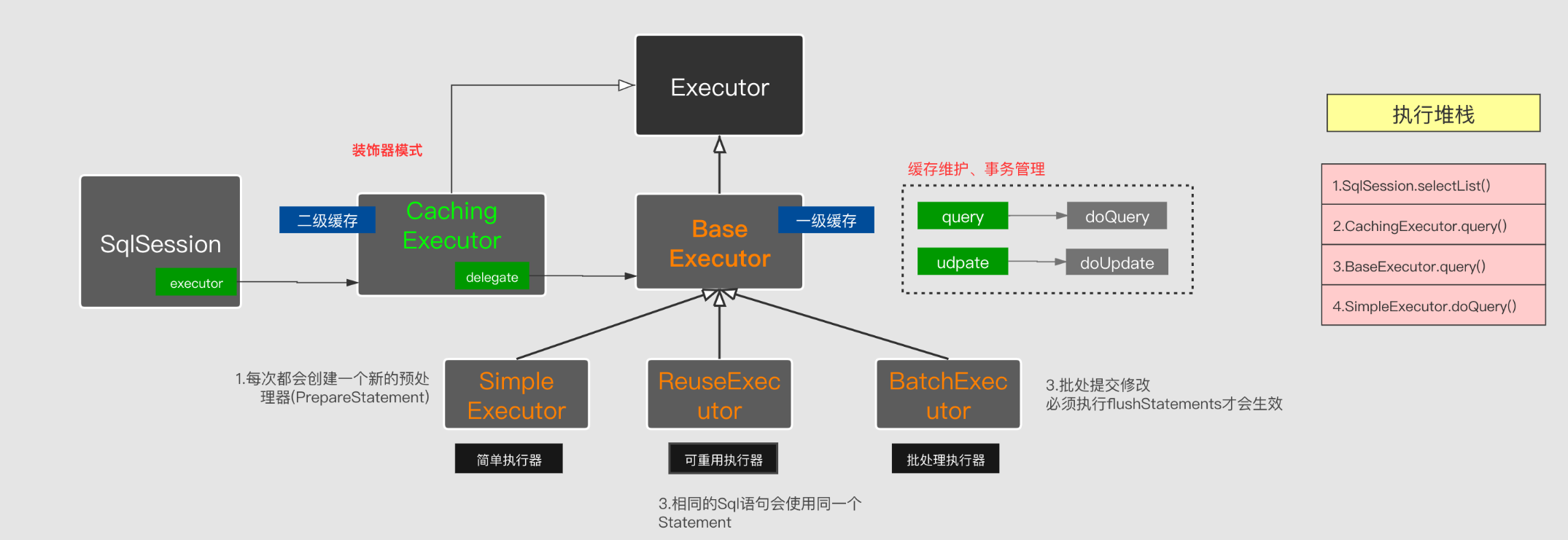protected Transaction transaction;
protected Executor wrapper;
protected ConcurrentLinkedQueue<DeferredLoad> deferredLoads;
protected PerpetualCache localCache;
protected PerpetualCache localOutputParameterCache;
protected Configuration configuration;
protected int queryStack;
private boolean closed;
protected BaseExecutor(Configuration configuration, Transaction transaction) {
this.transaction = transaction;
this.deferredLoads = new ConcurrentLinkedQueue<>();
this.localCache = new PerpetualCache("LocalCache");
this.localOutputParameterCache = new PerpetualCache("LocalOutputParameterCache");
this.closed = false;
this.configuration = configuration;
this.wrapper = this;
}
@Override
public Transaction getTransaction() {
if (closed) {
throw new ExecutorException("Executor was closed.");
}
return transaction;
}
@Override
public void close(boolean forceRollback) {
try {
try {
rollback(forceRollback);
} finally {
if (transaction != null) {
transaction.close();
}
}
} catch (SQLException e) {
log.warn("Unexpected exception on closing transaction. Cause: " + e);
} finally {
transaction = null;
deferredLoads = null;
localCache = null;
localOutputParameterCache = null;
closed = true;
}
}
@Override
public boolean isClosed() {
return closed;
}
@Override
public int update(MappedStatement ms, Object parameter) throws SQLException {
ErrorContext.instance().resource(ms.getResource()).activity("executing an update").object(ms.getId());
if (closed) {
throw new ExecutorException("Executor was closed.");
}
clearLocalCache();
return doUpdate(ms, parameter);
}
@Override
public List<BatchResult> flushStatements() throws SQLException {
return flushStatements(false);
}
public List<BatchResult> flushStatements(boolean isRollBack) throws SQLException {
if (closed) {
throw new ExecutorException("Executor was closed.");
}
return doFlushStatements(isRollBack);
}
@Override
public <E> List<E> query(MappedStatement ms, Object parameter, RowBounds rowBounds, ResultHandler resultHandler) throws SQLException {
BoundSql boundSql = ms.getBoundSql(parameter);
CacheKey key = createCacheKey(ms, parameter, rowBounds, boundSql);
return query(ms, parameter, rowBounds, resultHandler, key, boundSql);
}
@SuppressWarnings("unchecked")
@Override
public <E> List<E> query(MappedStatement ms, Object parameter, RowBounds rowBounds, ResultHandler resultHandler, CacheKey key, BoundSql boundSql) throws SQLException {
ErrorContext.instance().resource(ms.getResource()).activity("executing a query").object(ms.getId());
if (closed) {
throw new ExecutorException("Executor was closed.");
}
if (queryStack == 0 && ms.isFlushCacheRequired()) {
clearLocalCache();
}
List<E> list;
try {
queryStack++;
list = resultHandler == null ? (List<E>) localCache.getObject(key) : null;
if (list != null) {
handleLocallyCachedOutputParameters(ms, key, parameter, boundSql);
} else {
list = queryFromDatabase(ms, parameter, rowBounds, resultHandler, key, boundSql);
}
} finally {
queryStack--;
}
if (queryStack == 0) {
for (DeferredLoad deferredLoad : deferredLoads) {
deferredLoad.load();
}
deferredLoads.clear();
if (configuration.getLocalCacheScope() == LocalCacheScope.STATEMENT) {
clearLocalCache();
}
}
return list;
}
@Override
public <E> Cursor<E> queryCursor(MappedStatement ms, Object parameter, RowBounds rowBounds) throws SQLException {
BoundSql boundSql = ms.getBoundSql(parameter);
return doQueryCursor(ms, parameter, rowBounds, boundSql);
}
@Override
public void deferLoad(MappedStatement ms, MetaObject resultObject, String property, CacheKey key, Class<?> targetType) {
if (closed) {
throw new ExecutorException("Executor was closed.");
}
DeferredLoad deferredLoad = new DeferredLoad(resultObject, property, key, localCache, configuration, targetType);
if (deferredLoad.canLoad()) {
deferredLoad.load();
} else {
deferredLoads.add(new DeferredLoad(resultObject, property, key, localCache, configuration, targetType));
}
}
@Override
public CacheKey createCacheKey(MappedStatement ms, Object parameterObject, RowBounds rowBounds, BoundSql boundSql) {
if (closed) {
throw new ExecutorException("Executor was closed.");
}
CacheKey cacheKey = new CacheKey();
cacheKey.update(ms.getId());
cacheKey.update(rowBounds.getOffset());
cacheKey.update(rowBounds.getLimit());
cacheKey.update(boundSql.getSql());
List<ParameterMapping> parameterMappings = boundSql.getParameterMappings();
TypeHandlerRegistry typeHandlerRegistry = ms.getConfiguration().getTypeHandlerRegistry();
for (ParameterMapping parameterMapping : parameterMappings) {
if (parameterMapping.getMode() != ParameterMode.OUT) {
Object value;
String propertyName = parameterMapping.getProperty();
if (boundSql.hasAdditionalParameter(propertyName)) {
value = boundSql.getAdditionalParameter(propertyName);
} else if (parameterObject == null) {
value = null;
} else if (typeHandlerRegistry.hasTypeHandler(parameterObject.getClass())) {
value = parameterObject;
} else {
MetaObject metaObject = configuration.newMetaObject(parameterObject);
value = metaObject.getValue(propertyName);
}
cacheKey.update(value);
}
}
if (configuration.getEnvironment() != null) {
cacheKey.update(configuration.getEnvironment().getId());
}
return cacheKey;
}
@Override
public boolean isCached(MappedStatement ms, CacheKey key) {
return localCache.getObject(key) != null;
}
@Override
public void commit(boolean required) throws SQLException {
if (closed) {
throw new ExecutorException("Cannot commit, transaction is already closed");
}
clearLocalCache();
flushStatements();
if (required) {
transaction.commit();
}
}
@Override
public void rollback(boolean required) throws SQLException {
if (!closed) {
try {
clearLocalCache();
flushStatements(true);
} finally {
if (required) {
transaction.rollback();
}
}
}
}
@Override
public void clearLocalCache() {
if (!closed) {
localCache.clear();
localOutputParameterCache.clear();
}
}
protected abstract int doUpdate(MappedStatement ms, Object parameter) throws SQLException;
protected abstract List<BatchResult> doFlushStatements(boolean isRollback) throws SQLException;
protected abstract <E> List<E> doQuery(MappedStatement ms, Object parameter, RowBounds rowBounds, ResultHandler resultHandler, BoundSql boundSql)
throws SQLException;
protected abstract <E> Cursor<E> doQueryCursor(MappedStatement ms, Object parameter, RowBounds rowBounds, BoundSql boundSql)
throws SQLException;
protected void closeStatement(Statement statement) {
if (statement != null) {
try {
statement.close();
} catch (SQLException e) {
}
}
}
protected void applyTransactionTimeout(Statement statement) throws SQLException {
StatementUtil.applyTransactionTimeout(statement, statement.getQueryTimeout(), transaction.getTimeout());
}
private void handleLocallyCachedOutputParameters(MappedStatement ms, CacheKey key, Object parameter, BoundSql boundSql) {
if (ms.getStatementType() == StatementType.CALLABLE) {
final Object cachedParameter = localOutputParameterCache.getObject(key);
if (cachedParameter != null && parameter != null) {
final MetaObject metaCachedParameter = configuration.newMetaObject(cachedParameter);
final MetaObject metaParameter = configuration.newMetaObject(parameter);
for (ParameterMapping parameterMapping : boundSql.getParameterMappings()) {
if (parameterMapping.getMode() != ParameterMode.IN) {
final String parameterName = parameterMapping.getProperty();
final Object cachedValue = metaCachedParameter.getValue(parameterName);
metaParameter.setValue(parameterName, cachedValue);
}
}
}
}
}
private <E> List<E> queryFromDatabase(MappedStatement ms, Object parameter, RowBounds rowBounds, ResultHandler resultHandler, CacheKey key, BoundSql boundSql) throws SQLException {
List<E> list;
localCache.putObject(key, EXECUTION_PLACEHOLDER);
try {
list = doQuery(ms, parameter, rowBounds, resultHandler, boundSql);
} finally {
localCache.removeObject(key);
}
localCache.putObject(key, list);
if (ms.getStatementType() == StatementType.CALLABLE) {
localOutputParameterCache.putObject(key, parameter);
}
return list;
}
protected Connection getConnection(Log statementLog) throws SQLException {
Connection connection = transaction.getConnection();
if (statementLog.isDebugEnabled()) {
return ConnectionLogger.newInstance(connection, statementLog, queryStack);
} else {
return connection;
}
}
@Override
public void setExecutorWrapper(Executor wrapper) {
this.wrapper = wrapper;
}
private static class DeferredLoad {
private final MetaObject resultObject;
private final String property;
private final Class<?> targetType;
private final CacheKey key;
private final PerpetualCache localCache;
private final ObjectFactory objectFactory;
private final ResultExtractor resultExtractor;
public DeferredLoad(MetaObject resultObject,
String property,
CacheKey key,
PerpetualCache localCache,
Configuration configuration,
Class<?> targetType) {
this.resultObject = resultObject;
this.property = property;
this.key = key;
this.localCache = localCache;
this.objectFactory = configuration.getObjectFactory();
this.resultExtractor = new ResultExtractor(configuration, objectFactory);
this.targetType = targetType;
}
public boolean canLoad() {
return localCache.getObject(key) != null && localCache.getObject(key) != EXECUTION_PLACEHOLDER;
}
public void load() {
@SuppressWarnings("unchecked")
List<Object> list = (List<Object>) localCache.getObject(key);
Object value = resultExtractor.extractObjectFromList(list, targetType);
resultObject.setValue(property, value);
}
}
|
 MyBatis 是一款优秀的持久层框架,它支持自定义 SQL、存储过程以及高级映射。MyBatis 免除了几乎所有的 JDBC 代码以及设置参数和获取结果集的工作。MyBatis 可以通过简单的 XML 或注解来配置和映射原始类型、接口和 Java POJO(Plain Old Java Objects,普通老式 Java 对象)为数据库中的记录。
MyBatis 是一款优秀的持久层框架,它支持自定义 SQL、存储过程以及高级映射。MyBatis 免除了几乎所有的 JDBC 代码以及设置参数和获取结果集的工作。MyBatis 可以通过简单的 XML 或注解来配置和映射原始类型、接口和 Java POJO(Plain Old Java Objects,普通老式 Java 对象)为数据库中的记录。
